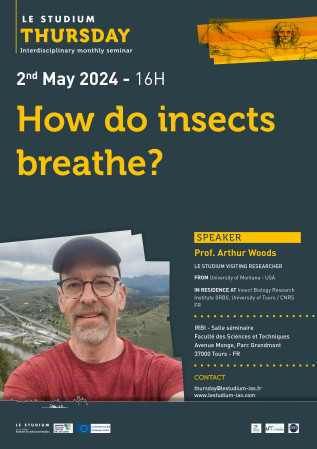Arthur Woods

From
In residence at
Insect Biology Research Institute (IRBI), University of Tours / CNRS - FR
Host scientist
Jérôme Casas
BIOGRAPHY
I am a biologist interested in biophysical and physiological aspects of interactions between animals and their environments. Much of my work in the past 15 years has focused on insect-plant interactions - specifically, on understanding the microclimatic experiences that insects have on leaf surfaces and their consequences for insect performance and fitness. Another major focus is the respiratory physiology of insects and marine invertebrates. We focus on understanding, for example, how insects in their natural habitats obtain oxygen and dump CO2 at sufficient rates under the broad diversity of conditions. This work typically focuses on the morphology and physiology of systems devoted to respiratory gas exchange, and to understanding how they evolve in related lineages. I was promoted to full professor at the University of Montana (USA) in 2017, with my work over the past 20 years funded primarily by the US National Science Foundation. My Google scholar page can be found here.
PROJECT
Application to microfluidics of chemically driven gas flows in insect tracheal systems
In insects, the key organ of gas exchange is the tracheal system, which delivers oxygen and removes carbon dioxide from all tissues via a set of ramifying, air-filled tubes. The proposed work examines a novel hypothesis about physicochemical mechanisms that may drive gas flows in tracheal systems. The hypothesis is derived from observations on the chemistry of the midgut in larval Lepidoptera (caterpillars), which typically supports extremely alkaline pH (values of 10 – 12). We propose that the alkaline midgut traps metabolic CO2 by converting it into bicarbonate and carbonate. As the midgut contents flow into the hindgut, they are re-acidified, which converts bicarbonate and carbonate back into gaseous CO2. The enormous pH gradients along the alimentary canal, coupled with the phase transitions between gaseous and solid forms of carbon, is likely to drive internal flows of gases from posterior to anterior within the large longitudinal tracheae. The proposed work aims to test this hypothesis using a combination of numerical modeling, tests on physical models of chemical reactors designed to mimic the chemical conditions along the alimentary canal, and measurements of the fluxes of 13C labeled CO2, bicarbonate, and carbonate within living caterpillars. The hypothesis has potential significance both for biology and for microfluidics engineering. In biological systems, there are few known gas-transporting mechanisms that originate from coupled chemical-physical systems; demonstrating the proposed flows would represent a fundamental advance in understanding how respiratory can be moved inside animals. In engineered microfluid systems, a key challenge is to move small quantities of fluids at controlled rates in appropriate directions. The proposed mechanism may thus provide a novel method for generating such flows.
Publications
Final reports
Insects transport respiratory gases in air-filled tracheal tubes, and a fundamental problem over the past century has been to understand how insects transport gases rapidly enough to support their metabolic rates under highly variables regimes of supply and demand. Here, using a mix of mathematical and physical models, we evaluate the roles that carbon dioxide plays in shaping tracheal structure and function in caterpillars. We first evaluate whether CO2 trapping by midgut fluids drives convective flows of oxygen toward tracheal tips. We then evaluate whether and how CO2 is recycled, via the tracheal system, between the highly alkaline midguts of caterpillars and their acidic hindguts. We conclude that, for caterpillars, there is only weak evidence for CO2-driven convective gas flows. Nevertheless, the models suggest that caterpillars can use convection driven by oxygen absorption to move CO2 rapidly from posterior to anterior parts of the tracheal system. Our results also suggest new approaches to key problems in microfluidics – namely, how to control the movements of gases and liquids within small channels.

